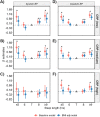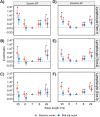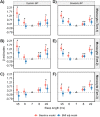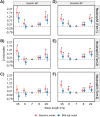Poor sleep and shift work associate with increased blood pressure and inflammation in UK Biobank participants
- PMID: 37925459
- PMCID: PMC10625529
- DOI: 10.1038/s41467-023-42758-6
Poor sleep and shift work associate with increased blood pressure and inflammation in UK Biobank participants
Abstract
Disrupted circadian rhythms have been linked to an increased risk of hypertension and cardiovascular disease. However, many studies show inconsistent findings and are not sufficiently powered for targeted subgroup analyses. Using the UK Biobank cohort, we evaluate the association between circadian rhythm-disrupting behaviours, blood pressure (SBP, DBP) and inflammatory markers in >350,000 adults with European white British ancestry. The independent U-shaped relationship between sleep length and SBP/DBP is most prominent with a low inflammatory status. Poor sleep quality and permanent night shift work are also positively associated with SBP/DBP. Although fully adjusting for BMI in the linear regression model attenuated effect sizes, these associations remain significant. Two-sample Mendelian Randomisation (MR) analyses support a potential causal effect of long sleep, short sleep, chronotype, daytime napping and sleep duration on SBP/DBP. Thus, in the current study, we present a positive association between circadian rhythm-disrupting behaviours and SBP/DBP regulation in males and females that is largely independent of age.
© 2023. The Author(s).
Conflict of interest statement
The authors declare no competing interests.
Figures








References
-
- Bortkiewicz, A. (BMJ Publishing Group Ltd and British Cardiovascular Society, 2022).
Publication types
MeSH terms
LinkOut - more resources
Full Text Sources
Medical

